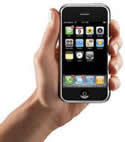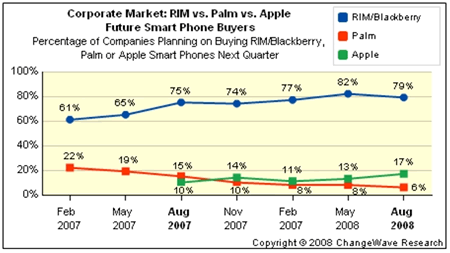 In this year’s Jacobs Media Tech Poll, we checked iPhone ownership at 3% in February – not bad for the rollout of a new gadget. But for Apple, the disturbing news was that only 2% of those who didn’t own one said they’d be very likely to purchase an iPhone this year, while 9% reported they were somewhat likely.
In this year’s Jacobs Media Tech Poll, we checked iPhone ownership at 3% in February – not bad for the rollout of a new gadget. But for Apple, the disturbing news was that only 2% of those who didn’t own one said they’d be very likely to purchase an iPhone this year, while 9% reported they were somewhat likely.
While these numbers would make the HD Radio Alliance happy, they did not strike us as great, and our "take" on the iPhone situation was that Apple would have to make some changes to make the iPhone more desirable to mainstream consumers – not just gadget freaks.
And last July, they did just that. The release of the iPhone 3G version was indeed the "game changer" that Apple claims it to be. There’s a buzz on iPhones, and it runs much deeper than "early adopters." Consider that in these difficult economic times, the one smartphone that companies are now gravitating toward is the iPhone, while there are down arrows for Palm phones and Blackberrys.

There are now 10 million iPhones across America, and Apple’s share of the smartphone category is moving up quickly – in this lousy economy.
Why the change? First, iPhone marketing is simple and attractive – it makes you want to go out and buy one. In just a 30-second spot, you can see how the device works.
Second, the iPhone has lived up to its advertised "game changer" claim. The Apple Store is loaded with cool applications that’s either inexpensive or free. You feel like a kid in a candy store when you browse through the various new apps, and of course, they are continually updated as new programs are created.
And third, opening up software development to the world and taking advantage of the ingenuity of geniuses everywhere was genius itself. Apple has tapped into the ultimate form of consumer-generated content. The potential of great new apps is unlimited, and each one generates its own form of buzz – apart from the device itself. ("Hey, check out this new app I just downloaded on my iPhone.")
This viral component is the key to the iPhone’s growth and proliferation, because Apple is more than content with outsiders now being the buzz engine for its gadget. In the same way that we’ve seen radio stations benefit from the creativity of its audience, the iPhone is deriving the benefits – word-of-mouth and revenue – from its smart users and crafty software designers.
As the RAB’s Jeff Haley announced at his annual meetings back in February, "Let’s agree here and now that our goal will be to have radio on every mobile phone, PDA, and mp3 player in the next five years."
Based on Apple’s progress with the iPhone, we’d be smart to accelerate that plan.
- What Is It With Female Robot DJs? - April 30, 2025
- Why “Dance With Those Who Brung You” Should Be Radio’s Operating Philosophy In 2025 - April 29, 2025
- The Exponential Value of Nurturing Radio Superfans - April 28, 2025




Don’t forget the lower price point. A $199 phone is a world of difference from a $399 phone for your average consumer. I would dare say that the lower price point was probably a much bigger factor than the app store, 3G, and GPS.
Cheap cool phone >>>> Expensive cool phone
The manufacturers of handsets and smartphones do lots of consumer research (which may be vexing to most radio people who have watched their industry all but abandon the practice) and believe me, if consumers wanted FM radio chips in them they would already be there.
One of the things that makes the iPhone so attractive is that it enables portability for so many of the things that people do now instead of listening to the radio.
FM radio’s in cell phones is like newspapers in laptops. Radio would be better off creating some unique apps for the iPhone, branding them and including some sort of attractive bounce-back.
The manufacturers of handsets and smartphones do lots of consumer research (which may be vexing to most radio people who have watched their industry all but abandon the practice) and believe me, if consumers wanted FM radio chips in them they would already be there.
One of the things that makes the iPhone so attractive is that it enables portability for so many of the things that people do now instead of listening to the radio.
FM radio’s in cell phones is like newspapers in laptops. Radio would be better off creating some unique apps for the iPhone, branding them and including some sort of attractive bounce-back.
The manufacturers of handsets and smartphones do lots of consumer research (which may be vexing to most radio people who have watched their industry all but abandon the practice) and believe me, if consumers wanted FM radio chips in them they would already be there.
One of the things that makes the iPhone so attractive is that it enables portability for so many of the things that people do now instead of listening to the radio.
FM radio’s in cell phones is like newspapers in laptops. Radio would be better off creating some unique apps for the iPhone, branding them and including some sort of attractive bounce-back.